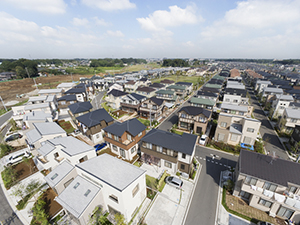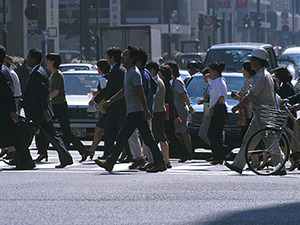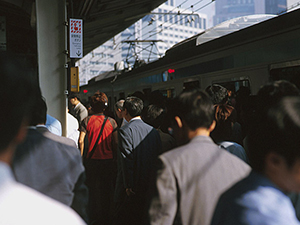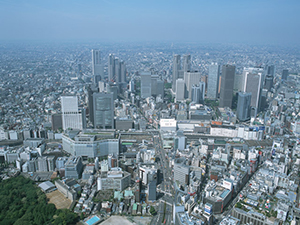Real Estate Concierge in Japan
REAL ESTATE INVESTMENT IN JAPAN
LIVES >> REAL ESTATE INVESTMENT IN JAPAN
Advancing Maturation and Signs of a Reversal
1. Japanese Macroeconomic Environment
 Population
Population
The Japanese population is shrinking accompanying the low birth rate and graying of society and the number of households will also begin declining.
The population peaked in 2005. The number of households is expected to continue increasing until 2019 before beginning a downward trend.
The growth rate of the Japanese economy is low compared to the other major countries, and significant economic growth in the future is not likely.
2012
According to an IMF forecast, the Japanese GDP growth rate over the next 5 years will be around 1%.
2013
With the change in administration, the Abenomics policies (bold monetary easing, expeditious fiscal policies, and growth strategy to encourage private sector investment) are targeting annual economic growth of at least 2%.
 Beyond 2013
Beyond 2013
The selection for Tokyo to host the Olympics is prompting a review of the circumstances surrounding real estate and construction. Redevelopment of railroads and roads, construction of stadiums and athletic facilities, and building of new hotels will continue up until the holding of the Olympics.
Size of the Economy
The size of the Japanese economy remains large and cannot be ignored as an investment target.
For nominal GNP Japan was passed by China to drop to third place, but if the current growth rate continues into the future, it is not expected to be caught by the fast-growing economies of India, Brazil, and Russia before 2020.
Currency exchange
The expected monetary easing, trade deficit, and other factors has changed the situation from a historically strong yen to a yen with underlying weakness.
This provides support for domestic exporting companies.
Foreign investors who buy while the yen is weak and sell when it is strong will benefit from foreign exchange gains.
 Price level
Price level
The Bank of Japan has set an inflation target of a 2% rise in the price level.
The bank intends to continue aggressive monetary easing "to achieve this as soon as possible."
Tokyo population
While the overall population of Japan is declining, population continues to flow into the Tokyo area.
This is due to a social as well as natural increase, so the increase in population and number of households in the Tokyo area is expected to continue increasing for the long term.
Corporations
Tokyo is home to the most major global companies in the world.
More Fortune Global 500 ranked companies are headquartered in Tokyo than in any other metropolis.
Tokyo 48, Beijing 44, Paris 19, New York 18, London 17
2. Summary of the Real Estate Investment Market in Japan
The Japanese real estate market is the second largest in the world and accounts for approximately 10% of the world total.
World |
$26,559 billion |
By Region |
|
Europe |
36.4% |
North America |
28.4% |
Asia |
27.0% |
Central & South America |
6.7% |
By Country |
|
USA |
25.4% |
Japan |
10.1% |
China |
7.0% |
Germany |
6.1% |
UK |
6.2% |
France |
4.7% |
Italy |
3.7% |
Size of the investment real estate markets in the Asia-Pacific region |
|
Japan |
$2,678 billion |
China |
$1,864 billion |
Australia |
$656 billion |
South Korea |
$467 billion |
India |
$350 billion |
Singapore |
$241 billion |
Hong Kong |
$211 billion |
Taiwan |
$198 billion |
Indonesia |
$189 billion |
Thailand |
$89 billion |
Malaysia |
$84 billion |
New Zealand |
$73 billion |
 The total return has recovered to around 4%, and the capital return also shows signs of turning positive.
The total return has recovered to around 4%, and the capital return also shows signs of turning positive.
- Since the summer of 2009, the decline in capital return has also stopped and is beginning to turn around. In addition, the income return has remained stable at the 5% level including before and after the Lehman Brothers shock.
The capitalization rate has recovered to the 2005 level and shows signs of continuing to grow.
- The capitalization rate of the Japanese market was on a downward track up to the first half of 2008, but rose after that.
- Thereafter, as of October 2012, it has remained flat, but the capitalization rate of housing is on a declining trend.
3.Real Estate Investment Product Market
 The J-REIT market that started in September 2001 has recovered to a current aggregate value of 7 trillion yen.
The J-REIT market that started in September 2001 has recovered to a current aggregate value of 7 trillion yen.
- The J-REIT market was launched in September 2001 with 2 issues and a current aggregate value of 250 billion yen.
- It currently has 39 issues and a size of approximately 7 trillion yen.
The TSE REIT index is rapidly rising along with the real estate industry index. - The TSE REIT index peaked in May 2007 and then declined greatly, but it has begun rapidly rising very recently.
The J-REIT divided yield rapidly rose to approximately 10%, but has currently declined to about 3%.
- The yield spread is at about the 2.5% level.
4.Office Market
Approximately 50% of the commercial real estate stock of Japan is concentrated in the Tokyo, Osaka, and Nagoya areas.
The Tokyo wards area accounts for 58% of the Japanese leased office market at 54,480,000 m2.
Osaka area |
17.8% |
Nagoya area |
5.5% |
Although the Tokyo vacancy rate is at a historic high, some areas are beginning to show a decline.
- The soft landing from the "Office 2003 problem" caused a rapid decline in the vacancy rate from 2005 to 2007. The conditions caused by the Lehman Brothers shock, however, caused this to rise rapidly to over 8%.
- Thereafter, the vacancy rate began to drop in some areas in 2012, falling below 8% in some cases.
Shibuya, Chiyoda, Chuo, and other wards
 The decline in leasing fees in the 5 central Tokyo wards is abating.
The decline in leasing fees in the 5 central Tokyo wards is abating.
The supply of large office buildings will slow from 2013 with around 10 buildings being added annually in the 23 wards of Tokyo.
- The number of large office buildings with a floor space of at least 10,000 m2 completed in 2012 numbered 34 buildings with 1.81million m2 of floor space, which is the third most ever.
- The impact of the earthquake delayed until 2012 the completion of 5 buildings that were scheduled for completion in 2011.
Although the capitalization rate has increased, it still remains at a level below 5%.
- The capitalization rate of the Tokyo office market has declined rapidly since 2000. This is due to participation by many equity investors and easier funds procurement from lenders.
- The Marunouchi capitalization rate has been at the 3% level since 2006, which was actually an unrecoverable level. Although the rate increased after the Lehman Brothers shock, it slowed again in 2009 and currently is maintaining a constant level.
5. Housing Market
 Approximately 20% of all households reside in rental apartments and this is on an increasing trend.
Approximately 20% of all households reside in rental apartments and this is on an increasing trend.
- The number of households living in rental apartments-private rental units, apartment housing (non-wooden structures)-was 3.32 million in 1988, approximately 9% of all households. This increased by 2.6 times to 8.77 million households (18% of all households) by 2008.
The number of rental apartment units supplied is accounting for an increasingly larger percentage of the total number of housing units.
- Looking at the change in the number of housing units, the number of single-family homes for rent is not increasing much, while the percentage of rental apartments (including public housing) is increasing faster than that for the overall number of housing units.
- For this reason, the share of rental housing accounted for by rental apartments has increased from about 60% to about 70%.

